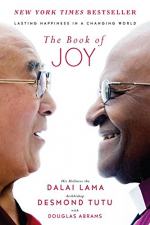|
This section contains 541 words (approx. 2 pages at 400 words per page) |

|
The Book of Joy Summary & Study Guide Description
The Book of Joy Summary & Study Guide includes comprehensive information and analysis to help you understand the book. This study guide contains the following sections:
This detailed literature summary also contains Topics for Discussion on The Book of Joy by Dalai Lama.
This three-part documentation of a week-long meeting between two of the world's most renowned spiritual leaders is crafted by author and activist Douglas Abrams. The topic of the week was joy. More specifically, the men attempted to create a road-map for ordinary people to cultivating a lasting sense of joy in their life, regardless of their suffering. Abrams divides the book into three sections; the first is dedicated to the nature of joy, where the men create a vague definition of joy as a lasting state, not just a fleeting emotion. The second section of the book addresses the most pressing obstacles humans face to joy. The third and final section of the text defines eight pillars to joy that the men have agreed upon throughout the weeks' worth of discussion. These pillars to joy are ultimately the discussion's conclusion: actively practicing the eight pillars to joy are the Dalai Lama and Archbishop Tutu's secret to attaining true, lasting joy.
The mission of the visit was not only to discuss joy, but to celebrate the Dalai Lamas's eightieth birthday. Thus, it is fitting that Abrams states in his introduction that the book is a three-layer birthday cake. The first layer comprising of specific teachings from the Dalai Lama and Archbishop Tutu, the second layer representing scientific findings on the nature of joy, and the third and final layer dedicated to a documentation of the personal, intimate reunion between the two old friends. Abrams incorporates all three of these layers to each of his chapters by including the words of the men themselves, scientific references, and his own human observations. Abrams incorporates these three sources of information seamlessly to fully incorporate the reader into the meeting room of the Dalai Lama's residence in Dharamsala, and ultimately into the conversation. While some may categorize this as a self-help book, it reads as more of a casual conversation. Abrams often digresses from the conversation to incorporate his own doubts, opinions, and observations, as well as the input from professionals and scientific experts, to make the conversation more fluent.
Abrams brings the discussion to a close by creating a convergence of the most important aspects to living a joyful life, as taught by the Dalai Lama and Archbishop Tutu throughout the week. They decide on eight pillars, four of the mind and four of the heart, that are essential to cultivating a joyful life. The pillars of the mind, perspective, humility, humor, and acceptance, and the pillars of the heart, forgiveness, gratitude, compassion, and generosity, are not offered as a foolproof system to attaining joy. Rather, each pillar represents a trait that one can actively practice throughout the duration of his or her life. The Dalai Lama and Archbishop Tutu reiterate several times that joy cannot be cultivated overnight. Also, joy will never come to those who actively seek it; Tutu warns that "we cannot pursue joy as an end in itself, or we will miss the bus" (303). This is the reason behind the eight pillars to joy - they are essentially a road map for living a meaningful and purposeful life. A life defined by a true sense of lasting joy is the byproduct of actively practicing the eight pillars to joy.
Read more from the Study Guide
|
This section contains 541 words (approx. 2 pages at 400 words per page) |

|



